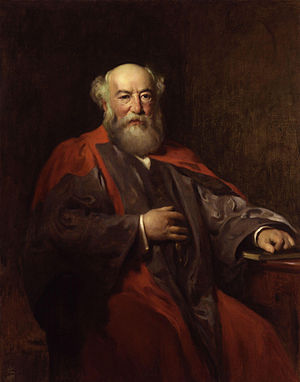The name Joseph Boehm may or may not be familiar to you, but it’s quite likely that you see his work on a daily basis. This prolific medallist and sculptor is responsible for the Jubilee head of Queen Victoria that you may see emblazoned on the 1887 Jubilee coinage. Further works are scattered in gardens, parks and museums throughout England.

Joseph was born in Vienna on July 6th of 1834. Sculpting and metal-work must have been in his blood, as his Hungarian father was director of Vienna’s imperial mint. Joseph had an early interest in the art form and spent a number of years studying plastic art in Italy and Paris before returning to work as a medallist in Vienna. In 1856, he launched into a full time career by winning the Austrian Imperial Prize for Sculpture.
He moved to England in the early 1860s and began furthering his studies in sculpture. His career skyrocketed in 1862 when he exhibited his work at the 1862 International Exhibition. Owing largely to his success at this exhibition, Joseph decided to leave aside his work with coins and medals and to focus his creative energies primarily on sculpting portrait busts and statuettes.
In 1866, Joseph Boehm became a naturalized British citizen. His works continued to gain notoriety across Britain, and the royal court began to take notice. Some of his first works for the royal court include an enormous marble statue of Queen Victoria for Windsor Castle (completed in 1869) and a monument of the Duke of Kent in St. George’s Chapel.
His star continued to rise, and he was made an Associate of the Royal Academy in 1878. In 1881, he was named sculptor in ordinary, and by 1882, he was elected to the Royal Academy.

In 1887, he was called upon to design a new effigy of Queen Victoria to be emblazoned on coins in commemoration of the Queen’s 50th year on the throne. Unfortunately, his design received harsh criticism from his artistic peers as well as from the public. Despite his painstaking work, numerous drafts and dozens of tweaks, the final product was the brunt of considerable mockery – particularly due to the “absurdly small crown” that perched on the Queen’s head. The design was eventually replaced in 1893.
Nonetheless, this snafu did little to hurt Joseph Boehm’s career. He continued his work as a prominent sculptor, commissioned by numerous members of Britain’s aristocracy. In 1889, he was granted the baronetcy of Wetherby Gardens in the Parish of St. Mary Abbots, Kensington, in the County of London.
Joseph went on to produce a great number of commissioned works for the Royal Family and members of the aristocracy. His sculpture of St. George and the Dragon can still be seen outside the State Library of Victoria, while his equestrian statue of the Duke of Wellington stands today at Hyde Park Corner.
A number of his more notable works also include a sculpture of Francis Drake, a memorial of General Charles George Gordon at St. Paul’s Cathedral, and a large sculpture of the stallion King Tom, which was created for Baron de Rothschild.
While he had an English wife and four children, there were rumours that Boehm was engaged in a romantic relationship with one of his pupils, Princess Louise, a daughter of Queen Victoria. Princess Louise was present at his house when Boehm passed away suddenly on December 12th, 1890 complementing the speculation.
























